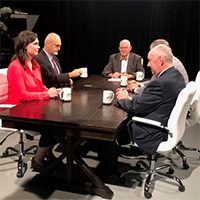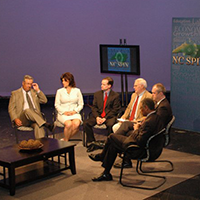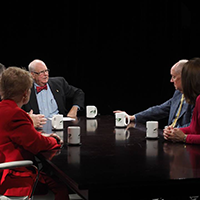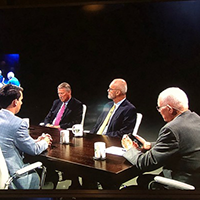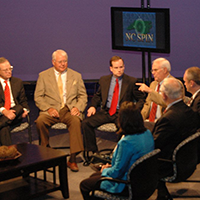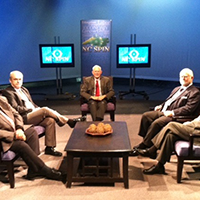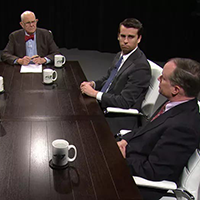Five weeks that felt like five years: Some reflections on where we are and where we are heading in 2024's election
Published August 1, 2024
For most academics, summer is a time to decompress and get caught up: on readings, maybe some research, prepping new material for the upcoming academic year's classes.
That's for most academics. For those of us in political science, especially who study American politics, this notion of a "summer break" has yet to materialize, and as I write this blog entry on July 31, it's likely not going to materialize.
This past month--really since June 27 and the first presidential debate--has felt like it's been five years of news wrapped up in five weeks. And the eight-day stretch from the attempted assassination on former president Trump through the RNC to Biden's bow-out and Harris's juggernaut nomination left a lot of us just gasping for air from all of the 'breaking news.'
And now, August.
Yes, we're being entertained by the Olympics (thank you for the critically needed distraction), but with the looming vice-presidential pick by now presumptive Democratic presidential nominee Harris, followed by the DNC in Chicago, along with the constant rallies from both sides and who knows what will happen, the dog-days of summer and this presidential campaign will continue on through August.
Only then do we get to the unofficial 'official' start to the general campaign on Labor Day and an absolute mad dash to November 5.
So what can we expect over the less than 100 days? Here's some thoughts, all with the caveat of 'who knows anymore' what can happen:
Fundraising: the powerhouse numbers of the Harris coalescence will likely break the bank on totals for this presidential year. And while Harris's campaign continues to build on its $200 million war chest, we'll likely see a corresponding uptick in Republican donations--because in this era of negative partisanship, one side absolutely, positively cannot stand to be upstaged by the other side. And speaking of...
Negative partisanship: even with the change at the top of the Democratic ticket, the power of negative partisanship will reign supreme through November. In recent public presentations, I give this comparison of how American voters negatively feel about the opposition party, from 1980 to 2020, based on a feeling thermometer of the most negative feelings, as gathered by the American National Election Studies surveys.
In 1980's election, less than 15 percent of both parties had a 'very cold' feeling towards the opposition party. But forty years later, over 60 percent of both parties had a 0-25 'very cold' feeling towards their partisan opponents.
If I had to make a prediction, we will likely see both figures move into the 70s for 2024's ANES survey. It's just the basic fact of American politics and partisan views: negativism rules.
Polling: with this election, and the past few cycles, polling will be a focal point of a lot of engaged voters' attention: who is up, down, and all around in the electoral battle for public opinion and approval?
But as most political scientists will sound like a broken record, it's important to know the following:
- Polls are 'snapshots in time.' Yes, we can get a sense of where things stand at that moment the poll was taken, but stay focused on the fact that we're trying to measure (with some good capabilities) human behavior.
- Don't think of the singular numbers reported, but rather the bandwidth numbers: meaning, what is the high and the low of the candidate's reported number, based on the margin of error of the poll. If both candidates fall into the same bandwidth--it's a statistical tie. And you have to deal with that mathematical fact.
- Follow the trends of the polls: that are numerous websites that will track each poll and put them into the context of what other polls are reporting. Watch the trend lines and remember the polling bandwidth.
- National polls are always fun, but it's more important to watch battleground state polling: Pennsylvania, Michigan, Wisconsin, North Carolina, Georgia, Nevada, and Arizona. Those are the critical states to watch.
For the Old North State, some thoughts of what I'll be watching for coming up:
NC's Early voting: we'll get a small taste of things when North Carolina begins mailing its requested absentee by mail ballots to voters starting on September 6 (and we could literally have the first ballots cast on September 7, two months before Election Day).
If NC's mail-in absentee voting continues its historic trends (except for 2020), we'll see the total number of ballots through the mail amount to around 3 to 5 percent of all ballots cast.
And yes, we'll be able to track who returns (but not who has requested) absentee by mail ballots, but again, reading those tea leaves won't get you anything but a bitter aftertaste. Let's wait until October 17 when in-person early voting begins and see who, and how many, are showing up out of the 7.5 million registered NC voters and gauge a sense of voter enthusiasm.
NC's MOE = NC's MOEV: NC's margins of electoral victories are usually in the margin of error: again, polling will be a fascination for many of us, but remember that most state-wide contests are decided by three percentage points or less. That's a 'margin of error' bandwidth that trying to predict who will win state-wide in North Carolina makes it a coin-toss dynamic at best.
These are just a few of the things to start contemplating and that we'll be tracking (along with numerous other aspects) here at Old North State Politics.
SERENITY NOW: If you need some serenity from all this (and trust me, I think we will all need some by the end of this election), this photo taken on a short family vacation last week (poor timing in the midst of everything going on, but it was well needed) may be the best I can do for you between now and November 5(ish).
 |
| The Snake River in the Grand Teton National Park |
Dr. Michael Bitzer holds the Leonard Chair of Political Science at Catawba College, where he is a professor of politics and history and the incoming director of the Center for North Carolina Politics & Public Service. You can find him on most social platforms with some version of @BowTiePolitics.



